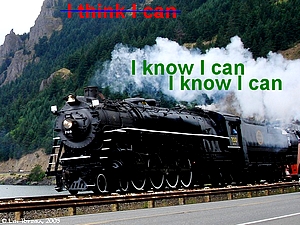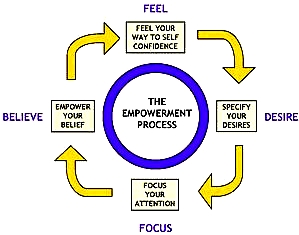How to Improve Confidence using Exercises, Activities, Games
Your level of self-confidence can be shown in many ways: how you speak, your body language, your behavior, what you say and how you say it, your willingness to speak up for yourself and your attitudes. People gain a sense of self-esteem and self-confidence when they see themselves completing tasks, mastering skills and achieving goals with a positive attitude. It is this confidence that is the kernel for success. It is this type of self confidence that encourages people to take on more difficult goals and tasks, and persist despite setbacks and slippages. Success breeds success, confidence builds more confidence. This overlaps with the concept of self-esteem, which is more general and relates to how people feel they can cope with what's happening in their lives. Partly, this is derived from a how people other people feel about and approve of themselves, which may or may not be controllable by the person affected.
Many people are naturally unsure of themselves and have a low opinion of their abilities. However self-confidence and self-esteem can be built and improved with positive thinking and affirmations. But what works best is to build self-confidence and positive feeling by setting and achieving goals. The reinforces the change in attitude.





The most common short-comings that develop from with low self-confidence are:
- Not being able to say NO!
- Letting people walk all over you rather than sticking up for yourself
- Being afraid to take risks as your lack of confidence holds you back
- Having self-doubt and expressing it
- Knocking yourself down all the time with self-criticism
- Anxiety and embarrassment when joining conversations in meeting or addressing groups of people
- Being to afraid to make conversation with strangers
- Letting your behavior be dictated by what other people think or what you think they will think
- Being willing to move out of your comfort zone, fearing failure and so avoiding any risks.
- Struggling to cover up your mistakes, hoping that you can fix the problem rather than admitting it and moving on
- Not showcasing your own virtues as often as you should.
- Dismissing compliments off-handedly and being too modest
How to Build Your Self-Confidence
Self-confidence is a skill that can be learned and developed through exercises, rather like building muscles through weight training. Regular confidence-building activities - like visualisation techniques and setting achievable goals and achieving them can be very effective way of building self-esteem and self-confidence. Many exercises involve positive attitudes and visualisation - standing up, shutting your eyes and visualizing a circular area into which you can step and feel confident to do risky things you would not feel confident about doing.
Building self-confidence can be done through effort, determination and the willingness to stick to it. Using the analogy of a journey there are our three steps to self-confidence:preparing for the journey; getting started; and building momentum to drive towards success.
Step 1: Preparing for Your Journey
To prepare you need to realistically assess how you feel about yourself, what you have achieved. You also need to think about where you want to go, how to get there and what yo will need along the way once you start. The elements of this are:
- List what you've already achieved - Think about your experiences so far, and list your10 best achievements. Write them all down in an achievement log or diary and use it to keep reminding yourself of these achievements.
- List your strengths - Review your achievements and your general abilities. After reflecting on your experiences, write down your strengths that have allowed you to real these goals. This analysis will help you identify your strengths.
- Develop a plan to define where you want to go and how to get there -Setting and accomplishing goals is the key, and genuine self-confidence flows from succeeding with goals set as exercises. Set goals that exploit your strengths, minimizes your flaws, recognize your possibilities, and control the risks you face.
- Start organising your mental approach - At this stage, you should start organising your mind. Learn to detect and counter and negative self-talk which can decimate your confidence. Create powerful mental pictures of yourself achieving your goals and overcoming your weaknesses.
- Commit yourself to success - Make a clear and firm commitment to yourself that you will do everything in your power to achieve your goals. As soon as any doubts start to surface, challenge and deal with them calmly and rationally.
- Learn the Balance Required for Self-Confidence - Self-confidence is striking the right balance between low self-confidence and being over-confident. If you are not confident enough, you will avoid taking risks and extending yourself; or you might not try at all. If you’re over-confident, you may take on too much risk, extend yourself beyond your capabilities, and fail. Being too optimistic may mean that you do not try hard enough. Getting the balance right is important for building self-confidence. With the correct amount of self-confidence, you will take measured risks, stretch yourself to the limits of your abilities and try hard.
Step 2: Setting Out on the Road to Self-Confidence
Having developed plan it is time to start on the journey:
- Build the knowledge you need to succeed - Look at your aims, recognise the skills you’ll need to reach your goals and build self confidence. Then work out how you can develop these skills. Don’t do it shallowly but do it properly by undertaking a course or program that will develop the skills required.
- Focus on the basics - When you’re starting, start with the basics and don't try anything too clever or elaborate. Don’t expect perfection. Do the simple things well one step at a time.
- Set small goals, achieve them, reward yourself and move to the next phase - Start with a set of small goals and move through them in sequence one at a time. Break the bigger goals into small steps and celebrate each small success.
- Keep managing your mind - Keep in charge of your thought to focus on positive attitudes, keep winning and celebrating your success, and keep mentally strong. Learn to handle failure without putting yourself down. Accept that mistakes happen and use them as positives by learning from them. Use mistakes as learning experiences and new goals.
Step 3: Driving Towards Success
By this stage, your self-confidence will be building and your will be aware of the success of the steps you have taken. Now it is time to start stretching yourself further by flexing your self-confidence muscles that you have developed. Start making larger and more ambitions goals and bigger risks.
- Keep yourself grounded – there are dangers of becoming over-confident and over-stretching yourself.
- Identify how self-confident you, are and how much you can stretch yourself - Set bigger goals to stretching yourself, but not too much.
- Compliment and reward yourself - Congratulate yourself an reward yourself for your achievements
- Transform your body language - This is a very important aspect for building your self confidence. It can showcase how confident you are and can generate positive responses. Learn to portray your building self-confidence by developing a more positive body language.
Other Tips for Showcasing Your Self Confidence
- Focus outside yourself
- Improve your fitness and have regular exercise
- Speak up at meetings and discussions
- Sit in the front row
- Compliment other people
- List what you are Grateful for
- List a Personal Commercial of your Strengths and Achievements
- Good Posture
- Walk Faster and Confidently
- Dress Sharp, Look Smart